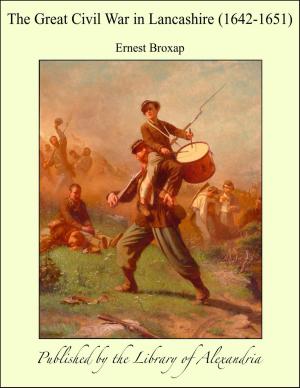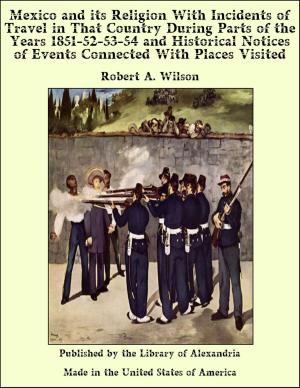The Story of the Atlantic Telegraph
Nonfiction, Religion & Spirituality, New Age, History, Fiction & Literature| Author: | Henry Martyn Field | ISBN: | 9781465526090 |
| Publisher: | Library of Alexandria | Publication: | March 8, 2015 |
| Imprint: | Language: | English |
| Author: | Henry Martyn Field |
| ISBN: | 9781465526090 |
| Publisher: | Library of Alexandria |
| Publication: | March 8, 2015 |
| Imprint: | |
| Language: | English |
THE BARRIER OF THE SEA. When Columbus sailed from the shores of Spain, it was not in search of a New World, but only to find a nearer path to the East. He sought a western passage to India. He had adopted a traditionary belief that the earth was round; but he did not once dream of another continent than the three which had been the ancient abodes of the human race—Europe, Asia, and Africa. All the rest was the great deep. The Florentine sage Toscanelli, from his knowledge of the world so far as then discovered, had made a chart, on which the eastern coast of Asia was represented as lying opposite to the western coast of both Europe and Africa. Accepting this theory, Columbus reasoned that he could sail direct from Spain to India. No intervening continent existed even in his imagination. Even after he had crossed the Atlantic, and descried the green woods of San Salvador rising out of the western seas, he thought he saw before him one of the islands of the Asiatic coast. Cuba he believed was a part of the mainland of India; Hayti was the Ophir of King Solomon; and when, on a later voyage, he came to the broad mouth of the Orinoco, and saw it pouring its mighty flood into the Atlantic, he rejoiced that he had found the great river Gihon, which had its rise in the garden of Eden! Even to the hour of his death, he remained ignorant of the real extent of his magnificent discovery. It was reserved to later times to lift the curtain fully from the world of waters; to reveal the true magnitude of the globe; and to unite the distant hemispheres by ties such as the great discoverer never knew. It is hard to imagine the darkness and the terror which then hung over the face of the deep. The ocean to the west was a Mare Tenebrosum—a Sea of Darkness, into which only the boldest voyagers dared to venture. Columbus was the most successful navigator of his time. He had made voyages to the Western Islands, to Madeira and the Canaries, to Iceland on the north, and to the Portuguese settlements in Africa. But when he came to cross the sea, he had to grope his way almost blindly. But a few rays of knowledge glimmered, like stars, on the pathless waters. When he sailed on his voyage of discovery, he directed his course, first to the Canaries, which was a sort of outstation for the navigators of those times, as the last place at which they could take in supplies; and beyond which they were venturing into unknown seas. Here he turned to the west, though inclining southward toward the tropics (for even the great discoverers of that day, in their search for new realms to conquer, were not above the consideration of riches as well as honor, and somehow associated gems and gold with torrid climes), and bore away for India! From this route taken by the great navigator, he crossed the ocean in its widest part. Had he, instead, followed the track of the Northmen, who crept around from Iceland to Greenland and Labrador; or had he sailed straight to the Azores, and then borne away to the north-west, he would much sooner have descried land from the mast-head. But steering in darkness, he crossed the Atlantic where it is broadest and deepest; where, as submarine explorers have since shown, it rolls over mountains, lofty as the Alps and the Himalayas, which lie buried beneath the surface of the deep. But farther north the two continents, so widely sundered, incline toward each Other, as if inviting that closer relation and freer intercourse which the fulness of time was to bring. As the island of Newfoundland is to stand in the foreground of our story, we observe on the map its salient geographical position. It holds the same relation to America that Ireland does to Europe. Stretching far out into the Atlantic, it is the vanguard of the western continent, or rather the signal-tower from which the New World may speak to the Old
THE BARRIER OF THE SEA. When Columbus sailed from the shores of Spain, it was not in search of a New World, but only to find a nearer path to the East. He sought a western passage to India. He had adopted a traditionary belief that the earth was round; but he did not once dream of another continent than the three which had been the ancient abodes of the human race—Europe, Asia, and Africa. All the rest was the great deep. The Florentine sage Toscanelli, from his knowledge of the world so far as then discovered, had made a chart, on which the eastern coast of Asia was represented as lying opposite to the western coast of both Europe and Africa. Accepting this theory, Columbus reasoned that he could sail direct from Spain to India. No intervening continent existed even in his imagination. Even after he had crossed the Atlantic, and descried the green woods of San Salvador rising out of the western seas, he thought he saw before him one of the islands of the Asiatic coast. Cuba he believed was a part of the mainland of India; Hayti was the Ophir of King Solomon; and when, on a later voyage, he came to the broad mouth of the Orinoco, and saw it pouring its mighty flood into the Atlantic, he rejoiced that he had found the great river Gihon, which had its rise in the garden of Eden! Even to the hour of his death, he remained ignorant of the real extent of his magnificent discovery. It was reserved to later times to lift the curtain fully from the world of waters; to reveal the true magnitude of the globe; and to unite the distant hemispheres by ties such as the great discoverer never knew. It is hard to imagine the darkness and the terror which then hung over the face of the deep. The ocean to the west was a Mare Tenebrosum—a Sea of Darkness, into which only the boldest voyagers dared to venture. Columbus was the most successful navigator of his time. He had made voyages to the Western Islands, to Madeira and the Canaries, to Iceland on the north, and to the Portuguese settlements in Africa. But when he came to cross the sea, he had to grope his way almost blindly. But a few rays of knowledge glimmered, like stars, on the pathless waters. When he sailed on his voyage of discovery, he directed his course, first to the Canaries, which was a sort of outstation for the navigators of those times, as the last place at which they could take in supplies; and beyond which they were venturing into unknown seas. Here he turned to the west, though inclining southward toward the tropics (for even the great discoverers of that day, in their search for new realms to conquer, were not above the consideration of riches as well as honor, and somehow associated gems and gold with torrid climes), and bore away for India! From this route taken by the great navigator, he crossed the ocean in its widest part. Had he, instead, followed the track of the Northmen, who crept around from Iceland to Greenland and Labrador; or had he sailed straight to the Azores, and then borne away to the north-west, he would much sooner have descried land from the mast-head. But steering in darkness, he crossed the Atlantic where it is broadest and deepest; where, as submarine explorers have since shown, it rolls over mountains, lofty as the Alps and the Himalayas, which lie buried beneath the surface of the deep. But farther north the two continents, so widely sundered, incline toward each Other, as if inviting that closer relation and freer intercourse which the fulness of time was to bring. As the island of Newfoundland is to stand in the foreground of our story, we observe on the map its salient geographical position. It holds the same relation to America that Ireland does to Europe. Stretching far out into the Atlantic, it is the vanguard of the western continent, or rather the signal-tower from which the New World may speak to the Old















